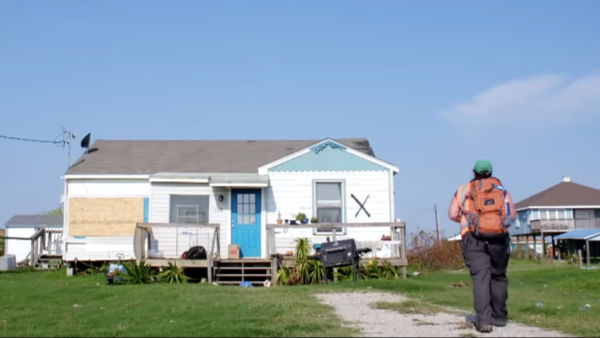Affordable Housing
There is a crisis in housing today
In the United States, 500,000 people on any given night are homeless; 3.9 million extremely low-income families do not have access to affordable housing; and there is a shortfall of at least 5 million units of workforce housing. Across the globe, 100 million people are homeless; 1 billion live in slums; and 1.6 billion lack adequate housing or shelter.
Through their research, faculty at the Fitzgerald Institute for Real Estate are working to meet the challenge of creating housing that is affordable, dignified, and safe. The Institute's faculty are generating research that examines questions on how to develop and sustain thriving neighborhoods, communities, and cities that will foster innovation, human and social capital, and virtuous citizens.
Through an approach that is evidence-based, market-oriented, and consistent with human dignity and the common good, the Institute believes that, in order to address the crisis in housing, scholars must evaluate the actual impact of policy interventions.
Featured Research
-
Analyzing the Effect of New Market-Rate Housing on Low-Income Housing
Prof. Mast has published, "The Effect of New Market-Rate Housing Construction on the Low-Income Housing Market," in the Journal of Urban Economics (2023).
Abstract

Evan Mast (Economics) I illustrate how new market-rate construction loosens the market for lower-quality housing through a series of moves. First, I use address history data to identify 52,000 residents of new multifamily buildings in large cities, their previous address, the current residents of those addresses, and so on for six rounds. The sequence quickly reaches units in below-median income neighborhoods, which account for nearly 40 percent of the sixth round, and similar patterns appear for neighborhoods in the bottom quintile of income or percent white. Next, I use a simple simulation model to roughly quantify these migratory connections under a range of assumptions. Constructing a new market-rate building that houses 100 people ultimately leads 45 to 70 people to move out of below-median income neighborhoods, with most of the effect occurring within three years. These results suggest that the migration ripple effects of new housing will affect a wide spectrum of neighborhoods and loosen the low-income housing market.
Media: Crain's Detroit (August 2019), New York Times (September 2019), Minneapolis Star-Tribune (January 2020), CityLab (June 2019), NPR Rochester (June 2019), City Observatory (April 2019), Strong Towns (April 2019), Conversable Economist (July 2019).
-
Assessing the Effects of Evictions
Collinson's article, "Eviction and Poverty in American Cities" (with John Eric Humphries, Nick Madar, Davin Reed, Daniel Tannenbaum and Winnie van Dijk), has been accepted at Quarterly Journal of Economics.
Abstract

Rob Collinson (Economics) More than two million U.S. households have an eviction case filed against them each year. Policymakers at the federal, state, and local levels are increasingly pursuing policies to reduce the number of evictions, citing harm to tenants and high public expenditures related to homelessness. We study the consequences of eviction for tenants using newly linked administrative data from two large cities. We document that prior to housing court, tenants experience declines in earnings and employment and increases in financial distress and hospital visits. These pre-trends are more pronounced for tenants who are evicted, which poses a challenge for disentangling correlation and causation. To address this problem, we use an instrumental variables approach based on cases randomly assigned to judges of varying leniency. We find that an eviction order increases homelessness, and reduces earnings, durable consumption, and access to credit. Effects on housing and labor market outcomes are driven by impacts for female and Black tenants.
(Coverage: The Economist, The Nation)
Collinson presented an earlier version of his paper at Notre Dame: "The Effects of Evictions on Low-Income Households" (with Davin Reed). Winner: Best Paper Award, Ohio State PhD Conference on Real Estate and Housing, 2018.
For more on Collinson's work on housing, visit: "Economist Explores How Some Dallas Renters Search for Home"
-
Designing a Better Form of Emergency Housing
Cusato is the internationally known designer of Katrina Cottages, 308-square-foot homes designed as an alternative to the Federal Emergency Management Agency (FEMA) trailers supplied as emergency housing for victims of 2005’s Hurricane Katrina.
-
Determining the Drivers of Inequality within Cities
Prof. Hoelzlein is investingating the drivers of inequality within cities by developing a quantiative model in his paper, "Two-Sided Sorting and Special Inequality in Cities."
Abstract

Matthias Hoelzlein (Economics) This paper studies how two-sided sorting of firms and households drives inequality within cities. I develop a quantitative model that features skill heterogeneity, non-homothetic demand for local consumption sectors and varying skill intensity in production. As a neighborhood become more skilled, firms catering to the rich and employing skilled workers enter, further reinforcing skill sorting. To validate the model’s mechanisms, I replicate the estimated impact of Empowerment Zones on household and firm sorting in model counterfactuals. I apply the model to explore how alternative policies employing two-sided sorting as a tool reach targeted populations more effectively and direct neighborhood change.
-
Developing Market-Based Solutions for Resilient Housing Globally
Kijewski-Correa designs and implements her own programming under Engineering2Empower and partners through the Integration Lab with Habitat for Humanity International and Catholic Relief Services to develop market-based resilient housing solutions for the US, Mexico, Haiti, India, Nepal and the Philippines.
For more on Kijewski-Correa's work on housing and structural damage from natural disasters, visit:
Fighting to Protect our Community
-
Engaging Landlords to Increase Opportunity
David Phillips has published "Landlords and Access to Opportunity" (with Dionissi Aliprantis & Hal Martin) in the Journal of Urban Economics (2022).
Abstract

David Phillips (Economics) A family can use a housing voucher to move to opportunity only if a landlord in an opportunity neighborhood accepts the voucher. Most landlords in opportunity neighborhoods, though, avoid voucher tenants. We examine a policy change that increases voucher rental payment limits only in high-rent neighborhoods. While the policy induces some new voucher holders to move into high-rent neighborhoods, most landlords do not change their screening behavior in response to the policy. Those landlords who do respond are few and operate at a surprisingly small scale. A sustainable policy of moving to opportunity requires more direct engagement with landlords.
-
Examining Private Claims to Public Property
Huber recently published "The Durability of Private Claims to Public Property" in the Georgetown Law Journal.
Abstract

Bruce Huber (Law) Property rights and resource use are closely related. Scholarly inquiry about their relation, however, tends to emphasize private property arrangements while ignoring public property — property formally owned by government. The well-known tragedies of the commons and anticommons, for example, are generally analyzed with reference to the optimal form and degree of private ownership. But what about property owned by the state? The federal government alone owns nearly one-third of the land area of the United States. One could well ask: is there a tragedy associated with public property, too?
If there is, here is what it might look like: private claims to public property are remarkably durable. Consider private claims to the lands and resources owned and managed by the federal government. Once established, these claims — of which there are hundreds of thousands — seem, in many instances, to take on a life of their own. Mining claims, leases for the development of coal or oil and gas, grazing permits, hydropower licenses, ski resort leases, even residential leases — claims such as these are often extended, expanded, renewed, and protected by law and by bureaucratic practices in ways that shape, and often trump, other policy objectives with respect to federal land. Newer claimants, and policies that would favor new land uses or alter the mix of uses, tend to be disfavored. These tendencies create a set of managerial and policymaking difficulties that constrain lawmakers and land managers and that ultimately disserve the interests of the citizens in whose interest state property ostensibly is managed.
This article examines the durability of private claims to public property, first, by providing a set of examples, and second, by explaining how the American historical experience and legal system combine to give public property this character. Third, it suggests implications for both theory and practice, in particular cautioning that lawmakers should take into account the phenomenon described here before granting new forms of access to various public resources.
-
Exploring the Mechanisms of Housing Production
Prof. Mast seeks to understand the mechanisms of houisng production in light of local control and land-use regulations in "Warding Off Development: Local Control, Housing Supply, and NIMBYs" (2022), published in The Review of Economics and Statistics.
Abstract

Evan Mast (Economics) Local control of land-use regulation creates a not-in-my-backyard (NIMBY) problem that can suppress housing construction, contributing to rising prices and potentially slowing economic growth. I study how increased local control affects housing production by exploiting a common electoral reform—changing from “at-large” to “ward” elections for town council. These reforms, which are not typically motivated by housing markets, shrink each representative’s constituency from the entire town to one ward. Results from a variety of difference-in-differences estimators show that this decentralization decreases housing units permitted by 20%, with similar effects on multi- and single-family permits. Effects are larger in whiter and higher-income towns.
-
Investigating the Effects of Law on Home Mortgage Discrimination
Maciá, recently hired as a visiting assistant professor, presented her paper on empirical analysis of housing discrimination at the Notre Dame Law and Economics Workshop: “How the Switch from Intent to Disparate Impact in Housing Discrimination Affects Race-Based Differentials in Mortgage Lending.”
Abstract

Maria Maciá (Law) This paper investigates the effect of changes in the legal standard for proving discrimination on lending differentials between black and white and hispanic and white applicants by exploiting a natural experiment arising when different US Circuits changed the standard at different times. Three different measurements that provide evidence for discrimination in the Home Mortgage Disclosure Act Data are used to assess this impact, two looking at minority-majority differentials in quantity and one measuring discrimination by looking at profitability. The measurement tracking rejection rates provides evidence that the movement to the disparate impact standard reduced the black-white and hispanic-white differentials in the decision to accept a home mortgage application. This is interpreted as evidence of a reduction in taste-based discrimination due to the analyzed loans being essentially risk-free for the banks. The measurement of profitability after the change in the legal standard provides evidence for a higher quality pool of accepted borrowers, which is also consistent with a reduction in taste-based discrimination.
-
Preventing Homelessness and Reducing Crime through Emergency Financial Assistance
Sullivan recently published a path-breaking article on homelessness, “Does emergency financial assistance reduce crime?” (with David Phillips & Caroline Palmer) in the Journal of Public Economics.
Abstract

Jim Sullivan (Economics) Does emergency financial assistance reduce criminal behavior among those experiencing negative shocks? To address this question, we exploit quasi-random variation in the allocation of temporary financial assistance to eligible individuals and families that have experienced an economic shock. Chicago's Homelessness Prevention Call Center (HPCC) connects such families and individuals with assistance, but the availability of funding varies unpredictably. Consequently, we can determine the impact of temporary assistance on crime by comparing outcomes for those who call when funds are available to those who call when no funds are available. Linking this call center information to arrest records from the Chicago Police Department, we find some evidence that total arrests fall between 1 and 2 years after the call. For violent crime, police arrest those for whom funds were available 51% less often than those who were eligible but for whom no funds were available. Single individuals drive this decrease. The decline in crime appears to be related, in part, to greater housing stability—being referred to assistance significantly decreases arrests for homelessness-related, outdoor crimes such as trespassing. However, we also find that financial assistance leads to an increase in property crime arrests. This increase is evident for family heads, but not single individuals; the increase is mostly due to shoplifting; and the timing of this increase suggests that financial assistance enables some families to take on financial obligations that they are subsequently unable to meet. Overall, the change in the mix of crime induced by financial assistance generates considerable social benefits due to the greater social cost of violence.
For more on Sullivan's work on housing and homelessness, visit:
“Study on Homelessness Prevention Published in Science”
“Sullivan presents homelessness prevention study on Capitol Hill”
-
Reevaluating the Link Between Property and Education
Prof. Garnett contributed a symposium article, "Decoupling Property and Education" (2023) in the Columbia Law Review.
Abstract

Nicole Stelle Garnett (Law) Over the past several years, the landscape of K–12 education policy has shifted dramatically, thanks in part to increasing prevalence of parental-choice policies, including intra- and inter-district public school choice, charter schools, and private-school choice policies like vouchers and (most recently) universal education savings accounts. These policies decouple property and education by delinking students’ educational options from their residential addresses. The wisdom and efficacy of parental choice as education policy is hotly debated, including among contributors to this Symposium. This Essay takes a step back from these education-policy debates and examines the underappreciated fact that decoupling property and education also advances at least three economic development goals. First, they decrease incentives for center-city residents to move from urban neighborhoods to suburban ones in order to secure space for their children in higher-performing suburban public schools. Second, they reduce the likelihood that urban Catholic and other faithbased schools will close, thereby stabilizing important neighborhood community institutions. Third, they lessen legal and economic barriers to mobility between municipalities within metropolitan regions, including exclusionary zoning, thereby addressing the persistent challenge of intrametropolitan economic inequality.
-
Studying the Local Effects of Large New Apartment Buildings
Prof. Mast has published, "Local Effects of Large New Apartment Buildings in Low-Income Areas," in The Review of Economics and Statistics (2023).
Abstract

Evan Mast (Economics) We study the local effects of new market-rate housing in low-income areas using microdata on large apartment buildings, rents, and migration. New buildings decrease rents in nearby units by about 6% relative to units slightly farther away or near sites developed later, and they increase in-migration from low-income areas. We show that new buildings absorb many high-income households and increase the local housing stock substantially. If buildings improve nearby amenities, the effect is not large enough to increase rents. Amenity improvements could be limited because most buildings go into already-changing neighborhoods or buildings could create disamenities such as congestion.
Media: New York Times (February 2020), Los Angeles Times (April 2019), Bloomberg (January 2020), Globe and Mail (January 2020), City Observatory (June 2019), Strong Towns (January 2020), Curbed SF (January 2020).
-
Understanding Policies that May Reduce and Prevent Homelessness
Evans & Phillips published, "Policies to Reduce and Prevent Homelessness: What We Know and Gaps in the Research" (with Krista Ruffini) (2021) in the Journal of Policy Analysis and Management.
Abstract
Homelessness may be both a cause of and one of the more extreme outcomes of poverty. Governments at all levels have a variety of tools to combat homelessness, and these strategies have changed dramatically over the past quarter century. In this paper, we catalog the policy responses, the existing literature on the effectiveness of these strategies, and the major gaps that need to be addressed in future research. We focus on studies from randomized controlled trial evaluations and the best quasi-experimental designs, and discuss outstanding questions that can be addressed with these same methods.

Bill Evans (Economics) 
David Phillips (Economics) -
Understanding Residential Racial Desegregation Programs
Collinson's paper, "The Long-Run Effects of Residential Racial Desegregation Programs: Evidence from Gautreaux" (with Eric Chyn), is under revise and resubmit at Quarterly Journal of Economics.
Abstract

Rob Collinson (Economics) This paper provides new evidence on the long-run effects of residential racial desegregation policies by studying the Gautreaux Assisted Housing Program. From the late 1970s until the 1990s, Gautreaux assisted thousands of Black families to move to predominately white, mostly suburban neighborhoods. We link historical program records to administrative data and use plausibly exogenous variation in neighborhood placements to estimate the effects of Gautreaux on the long-run outcomes of children. Being placed in a white neighborhood significantly increases children’s future lifetime earnings, employment, and wealth. Gautreaux children placed in a white neighborhood are also significantly more likely to be married and twice as likely to be married to a white spouse. Moreover, placements through Gautreaux impact the neighborhood choices of children in adulthood. Children placed in white neighborhoods during childhood live in more racially diverse neighborhoods with higher rates of upward mobility nearly 40 years later.

